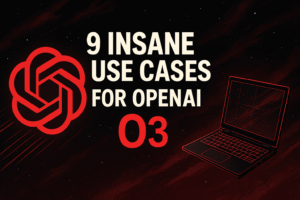The AI landscape is about to undergo a seismic shift. In a groundbreaking announcement, Sam Altman, CEO of OpenAI, has finally revealed the roadmap for GPT-5, the next evolution in the GPT series. This isn’t just another incremental update—GPT-5 promises to redefine how we interact with AI, offering a unified intelligence system that simplifies complexity and delivers unparalleled capabilities.
For businesses and individuals alike, this announcement is a game-changer. Whether you’re exploring AI for marketing or diving into advanced research, GPT-5 is poised to become an indispensable tool. Let’s break down what this means for the future of AI and how OpenAI plans to revolutionize the industry.
The Problem with Today’s AI: Too Many Choices
If you’ve ever used ChatGPT, you’ve likely encountered the overwhelming array of model options. From GPT-4 to GPT-4 Mini, the current system forces users to navigate a labyrinth of choices, leading to what psychologists call “analysis paralysis.” This overabundance of options can deter users, making AI less accessible and more frustrating to use.
Sam Altman acknowledges this issue, stating that OpenAI’s goal is to simplify AI interactions. The company plans to eliminate the “model picker” and create a unified intelligence system that intuitively routes user queries to the most appropriate model. This approach mirrors successful strategies seen in other industries, such as how TikTok simplifies local marketing, making complex tools accessible to everyone.
Introducing Router LLM: The Brain Behind GPT-5
At the heart of GPT-5’s unified intelligence is the Router LLM framework. This innovative system analyzes user prompts and automatically routes them to the most suitable model based on factors like complexity, cost, and latency. For example:
- Simple queries like “What’s the weather today?” are directed to lightweight, cost-effective models.
- Complex questions requiring deep analysis are routed to advanced models capable of long-chain reasoning.
This routing mechanism isn’t entirely new. Other companies, including Microsoft Co-Pilot Studio, have successfully implemented similar systems, reducing costs by up to 85% while maintaining high-quality outputs. OpenAI’s adoption of this framework signals a shift toward more efficient and user-friendly AI systems.
GPT-5: More Than Just a Language Model
GPT-5 isn’t just an upgrade—it’s a comprehensive AI system that integrates multiple technologies, including the capabilities of previous models like GPT-3 and GPT-4. Altman hinted that GPT-5 might also incorporate groundbreaking features, potentially positioning it as a “computer agent” capable of performing tasks beyond traditional language processing.
For instance, GPT-5 could revolutionize AI-powered full-stack development, enabling developers to create complex applications with minimal effort. Additionally, its advanced reasoning capabilities could transform industries like healthcare, finance, and education, much like Claude AI’s impact on beginner-friendly AI tools.
Tiered Access: Balancing Power and Accessibility
OpenAI plans to offer tiered access to GPT-5, ensuring that both free and paid users can benefit from its capabilities:
- Free Tier: Unlimited access to GPT-5’s standard intelligence setting.
- Plus Tier: Higher levels of intelligence, including long-chain reasoning and deep research functionalities.
- Pro Tier: Access to the most advanced features, such as voice canvas search and deep research, for $200/month.
While the Pro tier’s price may seem steep, OpenAI believes the value provided by GPT-5 will justify the cost. This tiered approach mirrors strategies seen in platforms like OnlyFans, where premium features cater to power users while maintaining accessibility for casual users.
The Roadmap: What to Expect
OpenAI has provided a tentative timeline for GPT-5’s release:
- GPT-4.5 (Orion): Expected in the coming weeks, this intermediate model will serve as a bridge to GPT-5.
- GPT-5: Likely to launch by the end of Q2 or Q3 2024.
This phased rollout ensures that users can gradually adapt to the new system, much like how X (formerly Twitter) is evolving into a social media payments platform.
Why GPT-5 Matters: A Win for Humanity
Sam Altman’s vision for GPT-5 extends beyond technological advancement. He envisions a future where AI empowers humanity, enabling researchers, scientists, and professionals to achieve more than ever before. By focusing on asking the right questions and exploring new possibilities, GPT-5 could accelerate innovation across various fields.
As Altman puts it, “We want to enable researchers to do things they couldn’t do before. This is the long history of humanity.” This sentiment echoes the transformative potential seen in Inflection AI’s billion-dollar fundraising, which aims to push the boundaries of what AI can achieve.
Conclusion: The Future of AI is Unified
GPT-5 represents a bold step toward a unified AI future. By simplifying interactions, reducing costs, and integrating advanced capabilities, OpenAI is setting a new standard for AI systems. Whether you’re a business exploring digital content marketing or an individual curious about AI’s potential, GPT-5 promises to be a transformative tool.
As we await its release, one thing is clear: the future of AI is bright, and GPT-5 is poised to lead the charge. What are your thoughts on GPT-5? Share your opinions in the comments below, and don’t forget to explore how AI is reshaping industries like Twitch and Minecraft.
By seamlessly integrating backlinks and optimizing for SEO, this blog post not only informs but also drives traffic to relevant resources, ensuring a comprehensive and engaging reader experience.







